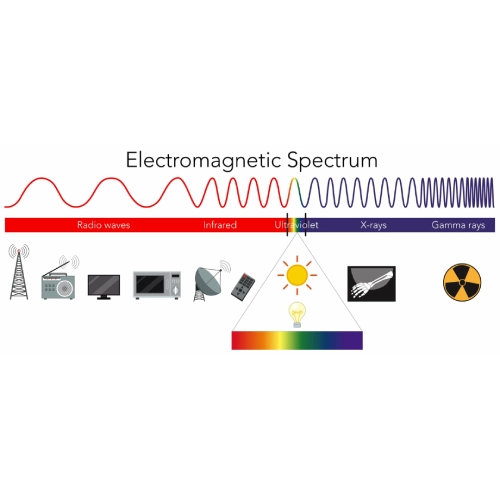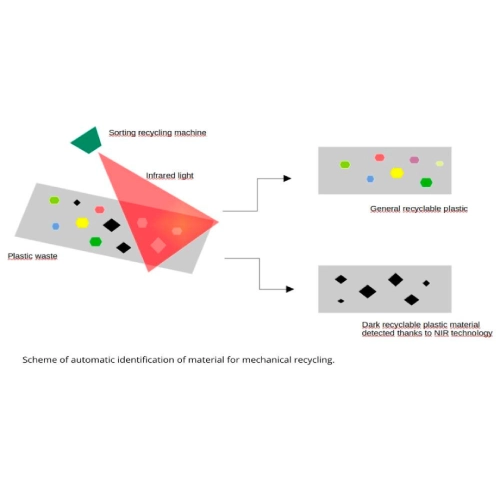
NIR Masterbatch: optimize plastic recycling
Sometimes, sorting waste is not enough. When we delve into the world of plastic recycling, we discover that it's not an intuitive topic. It’s well known that the type of polymer makes a difference, but did you know that pigments also play a crucial and often problematic role? Indeed, the absorption of light by dark-colored plastic can interfere with automatic sorting machines, making the recycling process tricky. This is particularly true for polymers pigmented with carbon black, creating a dilemma for manufacturers and recyclers. Don't worry, though; a solution exists, and we are here to reveal it: the secret lies in NIR-reflect masterbatch.
Carbon Black Pigment in Plastic
Let’s take a step back. What is carbon black? It is a pigment widely used in the **plastics **and color industry. It is the base of many dark color recipes, such as blacks, grays, browns, and blues. It is appreciated for its strong coloring power and competitive price. It is derived from the combustion of organic substances, mainly petroleum products and vegetable oils, giving it its characteristic deep black color. However, when it comes to recycling, carbon black presents a significant problem: its black color absorbs infrared light, making the plastic waste containing it unrecognizable to sorting machines.
What is NIR Infrared Light?
Naturally, you might be wondering, "Wait, what does infrared light have to do with recycling?" Infrared light (IR) is part of the electromagnetic spectrum with wavelengths longer than visible light but shorter than microwaves. IR light wavelengths range from about 700 nm to 1 mm. IR light is often associated with heat because objects that emit it (like the sun or human bodies) emanate infrared radiation. NIR (Near Infra-Red) light is a specific part of the infrared spectrum with wavelengths ranging from about 700 nm to 2500 nm. It is called "near-infrared" because it is closer to the visible part of the spectrum, just after visible red light. NIR light is often used in applications such as sensors and detectors.

NIR Masterbatch
However, as mentioned earlier, carbon black absorbs the infrared light emitted by the optical detector to "read" the differences between polymers. This makes the plastic waste invisible to sorting machines. When waste is not recognized, it cannot be directed to the appropriate recycling stream, hindering efforts for sustainable waste management. To address this problem, masterbatch producers are developing alternative solutions that allow dark plastic waste to be correctly detected. Among these solutions, at Gaypa, we have formulated the NIR masterbatch line. These are dark color formulations that replicate the tones and opacity of carbon black without interfering with the optical sorting process. In practice, NIR reflective pigments reflect infrared radiation instead of absorbing it.

How NIR Detectors work in plastic recycling
Infrared optical sorting machines, also known as NIR detectors, use infrared light to identify and separate different types of plastic. They operate through near-infrared spectroscopy. The machine scans the plastic waste moving quickly on a conveyor belt. Each polymer has specific reflectance curves. During the scan, infrared light is emitted and reflected by the polymers in the plastic waste. The signal received by the detector is analyzed within a few milliseconds and compared with reference spectra in a database. Once the type of plastic is determined, the waste is pushed to the appropriate chute.
An additional advantage
In addition to improving recycling, NIR reflective masterbatch offers another advantage: they significantly reduce the surface temperature of the plastic. When light radiation is absorbed, it is converted into heat, causing thermal accumulation. For example, have you ever parked your black car in the sun during summer and found it scorching hot after just 5 minutes? This is because a large part of solar radiation consists of infrared, which, as mentioned, heats and is more absorbed by dark colors. However, NIR reflective masterbatch reduces absorption, decreasing heat buildup and improving color fastness and thermal resistance of the polymer.
Why use NIR pigments
The choice of pigments in plastic production plays a crucial role throughout the life cycle of a product. From its design conception to the production process, to final recycling, color is a fundamental element not to be underestimated. Regarding managing black color, NIR masterbatch offers an innovative solution that not only improves the detectability of dark plastic waste in sorting centers but also provides additional benefits such as reducing heat accumulation for product preservation and color stability over time. By adopting these formulations, it is possible to contribute significantly to a more sustainable future and the continuous improvement of market innovations.

Want to learn more?
Materials science is our passion! Discover our line of NIR carbon black-free masterbatch.